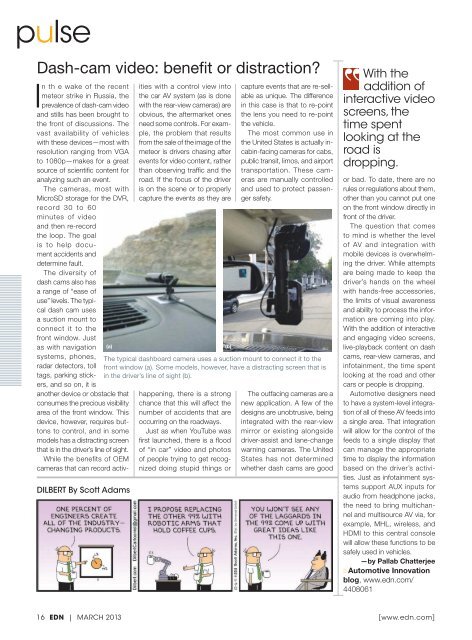201303.pdf 36567KB Mar 22 2013 09:11:22 PM
201303.pdf 36567KB Mar 22 2013 09:11:22 PM
201303.pdf 36567KB Mar 22 2013 09:11:22 PM
Create successful ePaper yourself
Turn your PDF publications into a flip-book with our unique Google optimized e-Paper software.
pulse<br />
Dash-cam video: benefit or distraction?<br />
In th e wake of the recent<br />
meteor strike in Russia, the<br />
prevalence of dash-cam video<br />
and stills has been brought to<br />
the front of discussions. The<br />
vast availability of vehicles<br />
with these devices—most with<br />
resolution ranging from VGA<br />
to 1080p—makes for a great<br />
source of scientific content for<br />
analyzing such an event.<br />
The cameras, most with<br />
MicroSD storage for the DVR,<br />
record 30 to 60<br />
minutes of video<br />
and then re-record<br />
the loop. The goal<br />
is to help document<br />
accidents and<br />
determine fault.<br />
The diversity of<br />
dash cams also has<br />
a range of “ease of<br />
use” levels. The typical<br />
dash cam uses<br />
a suction mount to<br />
connect it to the<br />
front window. Just<br />
as with navigation<br />
systems, phones,<br />
radar detectors, toll<br />
tags, parking stickers,<br />
and so on, it is<br />
(a)<br />
DILBERT By Scott Adams<br />
another device or obstacle that<br />
consumes the precious visibility<br />
area of the front window. This<br />
device, however, requires buttons<br />
to control, and in some<br />
models has a distracting screen<br />
that is in the driver’s line of sight.<br />
While the benefits of OEM<br />
cameras that can record activities<br />
with a control view into<br />
the car AV system (as is done<br />
with the rear-view cameras) are<br />
obvious, the aftermarket ones<br />
need some controls. For example,<br />
the problem that results<br />
from the sale of the image of the<br />
meteor is drivers chasing after<br />
events for video content, rather<br />
than observing traffic and the<br />
road. If the focus of the driver<br />
is on the scene or to properly<br />
capture the events as they are<br />
happening, there is a strong<br />
chance that this will affect the<br />
number of accidents that are<br />
occurring on the roadways.<br />
Just as when YouTube was<br />
first launched, there is a flood<br />
of “in car” video and photos<br />
of people trying to get recognized<br />
doing stupid things or<br />
capture events that are re-sellable<br />
as unique. The difference<br />
in this case is that to re-point<br />
the lens you need to re-point<br />
the vehicle.<br />
The most common use in<br />
the United States is actually incabin-facing<br />
cameras for cabs,<br />
public transit, limos, and airport<br />
transportation. These cameras<br />
are manually controlled<br />
and used to protect passenger<br />
safety.<br />
The typical dashboard camera uses a suction mount to connect it to the<br />
front window (a). Some models, however, have a distracting screen that is<br />
in the driver’s line of sight (b).<br />
(b)<br />
The outfacing cameras are a<br />
new application. A few of the<br />
designs are unobtrusive, being<br />
integrated with the rear-view<br />
mirror or existing alongside<br />
driver-assist and lane-change<br />
warning cameras. The United<br />
States has not determined<br />
whether dash cams are good<br />
With the<br />
addition of<br />
interactive video<br />
screens, the<br />
time spent<br />
looking at the<br />
road is<br />
dropping.<br />
or bad. To date, there are no<br />
rules or regulations about them,<br />
other than you cannot put one<br />
on the front window directly in<br />
front of the driver.<br />
The question that comes<br />
to mind is whether the level<br />
of AV and integration with<br />
mobile devices is overwhelming<br />
the driver. While attempts<br />
are being made to keep the<br />
driver’s hands on the wheel<br />
with hands-free accessories,<br />
the limits of visual awareness<br />
and ability to process the information<br />
are coming into play.<br />
With the addition of interactive<br />
and engaging video screens,<br />
live-playback content on dash<br />
cams, rear-view cameras, and<br />
infotainment, the time spent<br />
looking at the road and other<br />
cars or people is dropping.<br />
Automotive designers need<br />
to have a system-level integration<br />
of all of these AV feeds into<br />
a single area. That integration<br />
will allow for the control of the<br />
feeds to a single display that<br />
can manage the appropriate<br />
time to display the information<br />
based on the driver’s activities.<br />
Just as infotainment systems<br />
support AUX inputs for<br />
audio from headphone jacks,<br />
the need to bring multichannel<br />
and multisource AV via, for<br />
example, MHL, wireless, and<br />
HDMI to this central console<br />
will allow these functions to be<br />
safely used in vehicles.<br />
—by Pallab Chatterjee<br />
▷Automotive Innovation<br />
blog, www.edn.com/<br />
4408061<br />
16 EDN | <strong>Mar</strong>ch <strong>2013</strong> [ www.edn.com ]






![[270].pdf 37407KB Sep 02 2010 09:55:57 AM - ElectronicsAndBooks](https://img.yumpu.com/50350834/1/185x260/270pdf-37407kb-sep-02-2010-095557-am-electronicsandbooks.jpg?quality=85)
![draaien, A Viruly 1935 OCR c20130324 [320]. - ElectronicsAndBooks](https://img.yumpu.com/49957773/1/190x252/draaien-a-viruly-1935-ocr-c20130324-320-electronicsandbooks.jpg?quality=85)



![20051110 c20051031 [105].pdf 35001KB Feb 18 2009 08:46:32 PM](https://img.yumpu.com/48687202/1/190x253/20051110-c20051031-105pdf-35001kb-feb-18-2009-084632-pm.jpg?quality=85)





